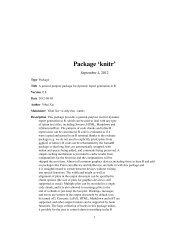Package 'openair'
Package 'openair'
Package 'openair'
Create successful ePaper yourself
Turn your PDF publications into a flip-book with our unique Google optimized e-Paper software.
120 TheilSenDetailsdate.breaks- 1) / (end.year - start.year). Where C.start is the concentration at the start dateand C.end is the concentration at the end date.For avg.time = "year" (end.year - start.year) will be the total number of years- 1. For example, given a concentration in year 1 of 100 units and a percentagereduction of 5 but the actual time span will be 6 years i.e. year 1 isused as a reference year. Things are slightly different for monthly values e.g.avg.time = "month", which will use the total number of months as a basis ofthe time span and is therefore able to deal with partial years. There can be slightdifferences in the estimate therefore, depending on whether monthly or annualvalues are considered.Number of major x-axis intervals to use. The function will try and choose a sensiblenumber of dates/times as well as formatting the date/time appropriately tothe range being considered. This does not always work as desired automatically.The user can therefore increase or decrease the number of intervals by adjustingthe value of date.breaks up or down.... Other graphical parameters passed onto cutData and lattice:xyplot. For example,TheilSen passes the option hemisphere = "southern" on to cutDatato provide southern (rather than default northern) hemisphere handling of type = "season".Similarly, common axis and title labelling options (such as xlab, ylab, main)are passed to xyplot via quickText to handle routine formatting.The TheilSen function provides a collection of functions to analyse trends in air pollution data.The Mann-Kendall test is a commonly used test in environmental sciences to detect the presenceof a trend. It is often used with the Theil-Sen (or just Sen) estimate of slope. See references. TheTheilSen function is flexible in the sense that it can be applied to data in many ways e.g. by day ofthe week, hour of day and wind direction. This flexibility makes it much easier to draw inferencesfrom data e.g. why is there a strong downward trend in concentration from one wind sector and notanother, or why trends on one day of the week or a certain time of day are unexpected.For data that are strongly seasonal, perhaps from a background site, or a pollutant such as ozone, itwill be important to deseasonalise the data (using the option deseason = TRUE.Similarly, for datathat increase, then decrease, or show sharp changes it may be better to use smoothTrend.Note! that since version 0.5-11 openair uses Theil-Sen to derive the p values also. This is toensure there is consistency between the calculated p value and other trend parameters i.e. slopeestimates and uncertianties. This change may slightly affect some of the p-estimates previouslygiven by openair because the p estimates are now calculated using bootstrap resampling by defaultand previously they were not. However, users can still for the moment call the TheilSen functionusing MannKendallSome of the code used in TheilSen is based on that from Rand Wilcox http://www-rcf.usc.edu/~rwilcox/. This mostly relates to the Theil-Sen slope estimates and uncertainties. Furthermodifications have been made to take account of correlated data based on Kunsch (1989). The basicfunction has been adapted to take account of auto-correlated data using block bootstrap simulationsif autocor = TRUE (Kunsch, 1989). We follow the suggestion of Kunsch (1989) of setting theblock length to n(1/3) where n is the length of the time series.The slope estimate and confidence intervals in the slope are plotted and numerical informationpresented.
















